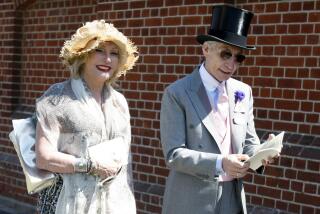Stanley Meisler dies at 85; veteran L.A. Times foreign correspondent wrote on war, art, civil rights
Stanley Meisler, a longtime foreign correspondent for the Los Angeles Times and author of several books on foreign affairs and art — including a well-regarded history of the Peace Corps — died Sunday of cardiac arrest in Washington, D.C., said his wife, Elizabeth Fox. He was 85.
Meisler retired from the Times in 1998 but never stopped working: his last freelance piece for the paper — on the artist William Merritt Chase — was published the day of his death.
Over three decades as a foreign and diplomatic correspondent for the Times, Meisler’s assignments included Nairobi, Barcelona, Paris, Mexico City and Toronto. He covered the Rev. Martin Luther King Jr.’s 1963 March on Washington, the aftermath of the fall of the Berlin Wall and terrorist bombings in France in the 1980s.
Meisler was a self-taught expert on art, the subject of much of his freelance work, and a 2015 book: “Shocking Paris: Soutine, Chagall and the Outsiders of Montparnasse.”
Meisler was so well-traveled that he served as a kind of living travel guide for friends, advising them on restaurants and landmarks wherever they happened to be going, said friend and colleague Bob Rosenblatt. The United Nations was his longtime beat, and the subject of his 1996 history of the institution. Meisler also wrote a biography of U.N. Secretary-General Kofi Annan.
“He was enthusiastically cynical,” Rosenblatt said. “He liked his stories, and he enjoyed it all, but he had appropriate skepticism.”
Stanley Meisler was born May 14, 1931, in the Bronx, N.Y., to Jean Wolf and Meyer Meisler, a Polish immigrant who hung wallpaper for a living. He went to James Monroe High and City College New York where he earned a degree in English. He did graduate work at UC Berkeley but did not complete a degree.
His first journalism job was at a small paper in a small town: Middletown, Ohio. He worked for the Associated Press from 1954 to 1964 in New Orleans and Washington and then for the Peace Corps, where he became deputy director of the Office of Evaluation and Research. In 2011 he wrote a book on the Peace Corps, “When the World Calls: The Inside Story of the Peace Corps and Its First Fifty Years.”
In 1967, he was sent to Nairobi by The Times. After many foreign assignments, he went to New York to cover the United Nations in the 1990s, and at his retirement in 1998 was covering foreign affairs in Washington.
He went straight back to work after retirement.
He did numerous freelance articles for The Times and Smithsonian, and also contributed to other publications, including the Atlantic, the Nation and Foreign Affairs.
Although he had no formal training in art, his expertise was such that he helped give tours of the National Gallery for a college alumni group, Rosenblatt said. “He seemed to know all this the way a professor did,” Rosenblatt said.
He wrote about art, not as a critic, but as a storyteller — reporting it, just as he had previously reported diplomatic news and international tragedies. He also pursued his interests in fine cooking and fine restaurants, and organized a regular social gathering of retired journalists.
He was “a sensational writer,” said another former Times colleague, Ronald Ostrow. “He had a sharp sense of humor. He seemed resistant to authority in the form of editors and such, but it wasn’t just, ‘editors do no right.’ He was sure of what he was doing.”
“He loved clear writing … and he loved, loved stories. He went after stories you wouldn’t think of,” said his wife, who directs the Office of Health, Infectious Diseases and Nutrition for U.S. Agency for International Development.
They met in Argentina around the time of the Falklands War. She was a source for a story. They married in 1984.
In a 1986 article about the French reconciling with the legacy of the Dreyfus affair, Meisler wrote: “France has divided often in the 20th Century in titanic, bitter struggles.”
He provided a brief list — left versus right, De Gaulle versus Vichy, French Algeria versus reality, etc. — then concluded: “The Dreyfus case has always seemed to set the pattern for these conflicts.”
Besides his wife, he is survived by two sons and eight grandchildren.
More to Read
Start your day right
Sign up for Essential California for the L.A. Times biggest news, features and recommendations in your inbox six days a week.
You may occasionally receive promotional content from the Los Angeles Times.





